Have you ever wondered how auto repair shops lift cars and trucks for repairs?
Auto repair lifts are essential tools designed to safely raise vehicles, allowing workers to access the underside for maintenance and repairs. These lifts come in various shapes, sizes, and capacities, from heavy-duty models to portable ones suited for smaller spaces.
A high-quality lift not only enhances safety but also boosts efficiency by saving time and reducing physical strain.
Let’s explore it!
Types of Auto Repair Lifts
1. Two-post Lifts
Two-post auto repair lifts are a great choice for shops that work on sedans, SUVs, and smaller trucks.
Here’s more:
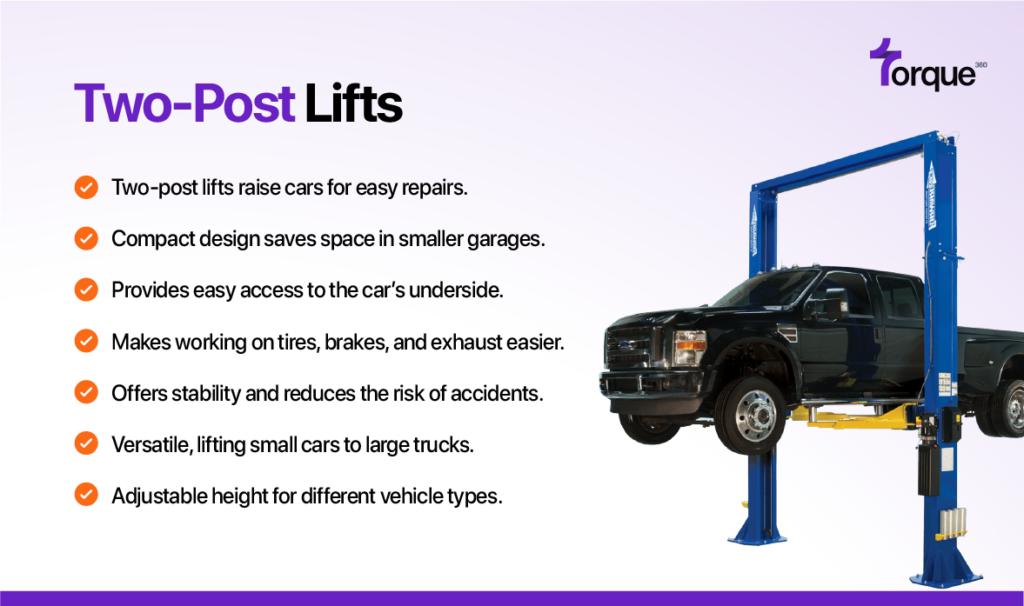
These lifts come in four different designs, each offering unique features to fit your shop’s needs.
Symmetrical Two-Post Lifts
These lifts have evenly spaced columns and arms, making them perfect for a variety of vehicle types. They are highly versatile and can handle many different kinds of cars and trucks.
Asymmetrical Two-Post Lifts
With unevenly spaced columns, these lifts give easier access to the vehicle’s interior. This makes them a good choice for shops that need quick access to the inside of vehicles.
Versymmetric Two-Post Lifts
These lifts combine both symmetrical and asymmetrical features, giving you the best of both worlds. They offer flexibility in lifting and are ideal for a wide range of vehicles.
Click here to learn more about “Symmetric vs. Asymmetric Lifts.”
Overhead Two-Post Lifts
The hydraulic parts of these lifts are positioned above the vehicle, giving more clearance. This design is great for shops with limited floor space or those needing more room to work around vehicles.
Choosing the right two-post lift depends on your shop’s layout and the types of vehicles you work on. If space is a concern, two-post lifts are a reliable, affordable option that can easily fit into smaller areas while still providing the lifting power you need.
2. Four-Post Lift
A four-post lift is a tool used to lift cars and trucks in auto repair shops. It gets its name from the four strong posts that support the vehicle while it is raised.
These lifts are very stable, making them a great choice for lifting heavy cars or trucks. Unlike other lifts, the car sits on ramps and is raised by the four posts.
This design makes it easier to lift large or wide vehicles that might not fit on other types of lifts.
Here’s more:
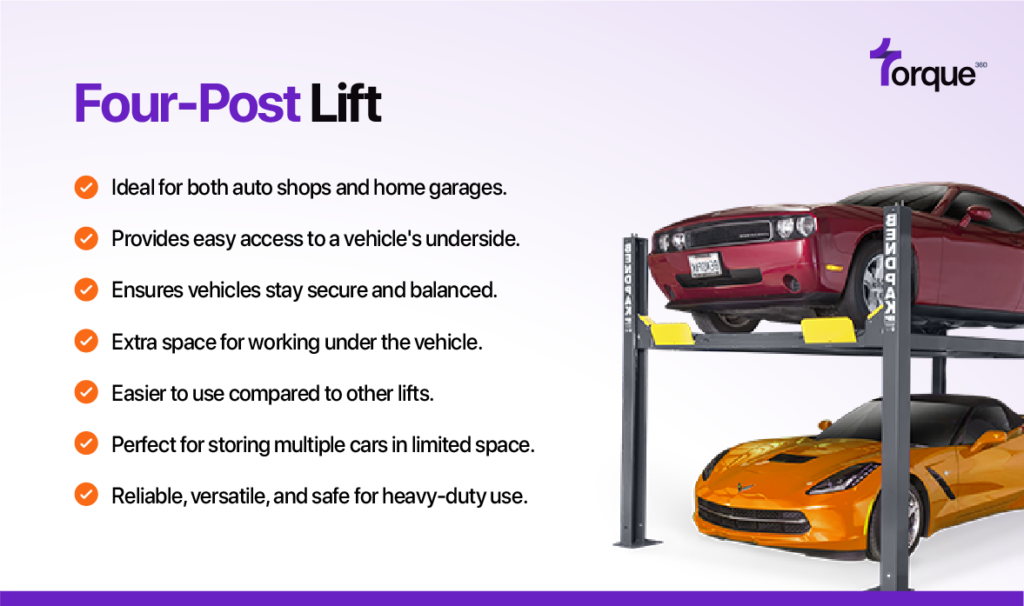
3. Scissor Car Lifts
A scissor car lift is a tool that raises cars off the ground. It uses a unique scissor-like mechanism to lift the vehicle. This type of lift is excellent for small garages or shops with limited space. The lift works by pushing the arms together, which causes the platform to rise.
Scissor lifts are known for their compact design. They do not take up much space when lowered, so they are ideal for places where space is tight. Unlike other lifts, scissor lifts are usually smaller, making them a good option for home garages or small repair shops.
Here’s more:
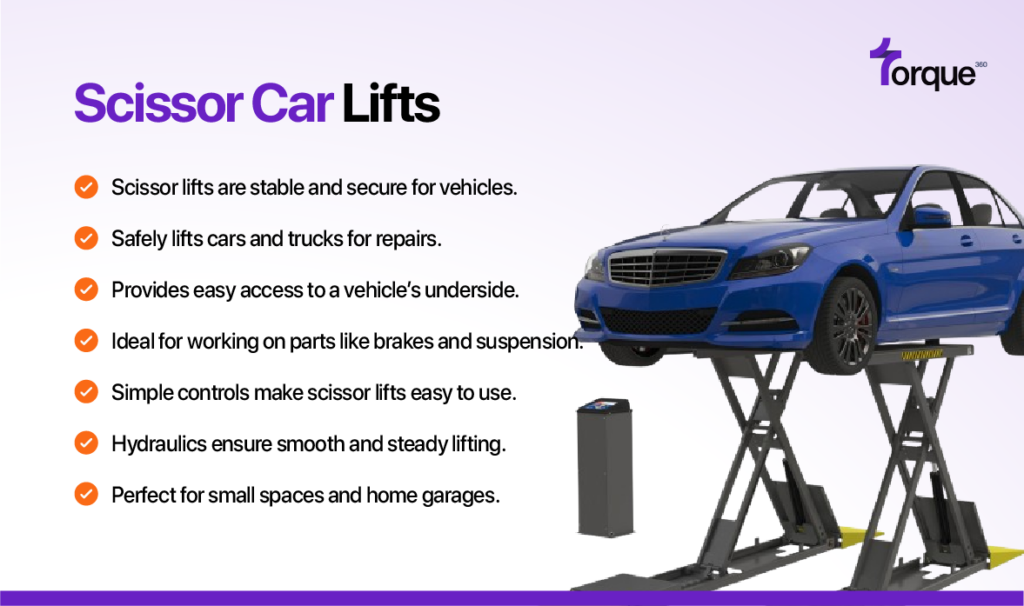
4. Portable Car Lifts
A portable car lift is a small, movable tool used to lift cars. It’s designed for easy use and can be moved around a garage or workspace.
One of the best things about portable car lifts is how easy they are to set up. They don’t require permanent installation like other types of lifts.
You can simply roll them into place, lift the car, and start working. This is a huge advantage if you need to move the lift around or don’t have a lot of room in your garage.
Here’s more:
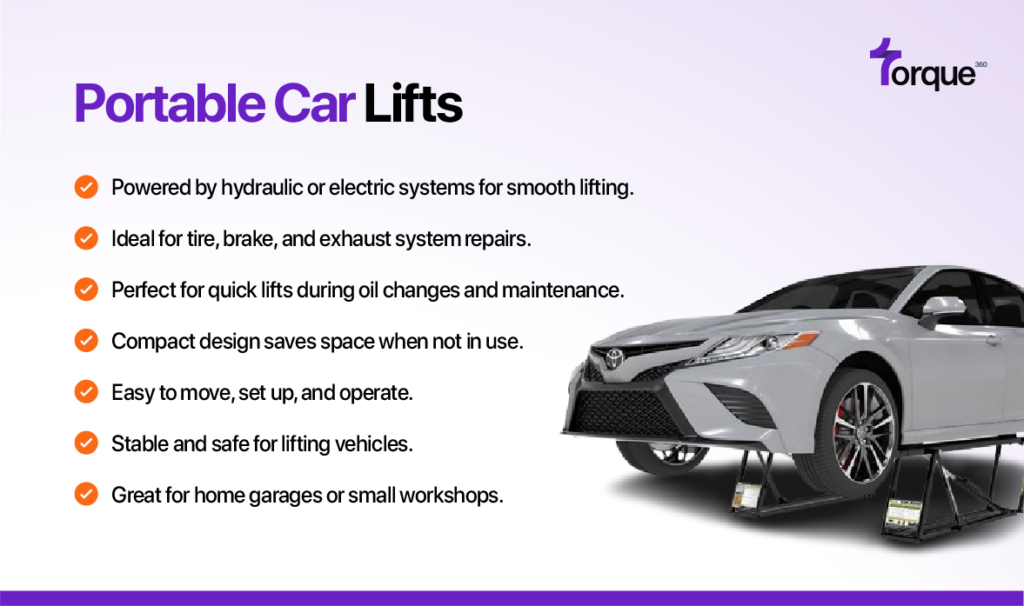
5. In-Ground Car Lifts
An in-ground car lift is built into the floor of a garage or shop. It’s different from other lifts because it stays hidden when not in use.
The lift works by lifting the car up from below, using a hydraulic system. In-ground lifts are often found in large auto repair shops and service centers.
Here’s more:
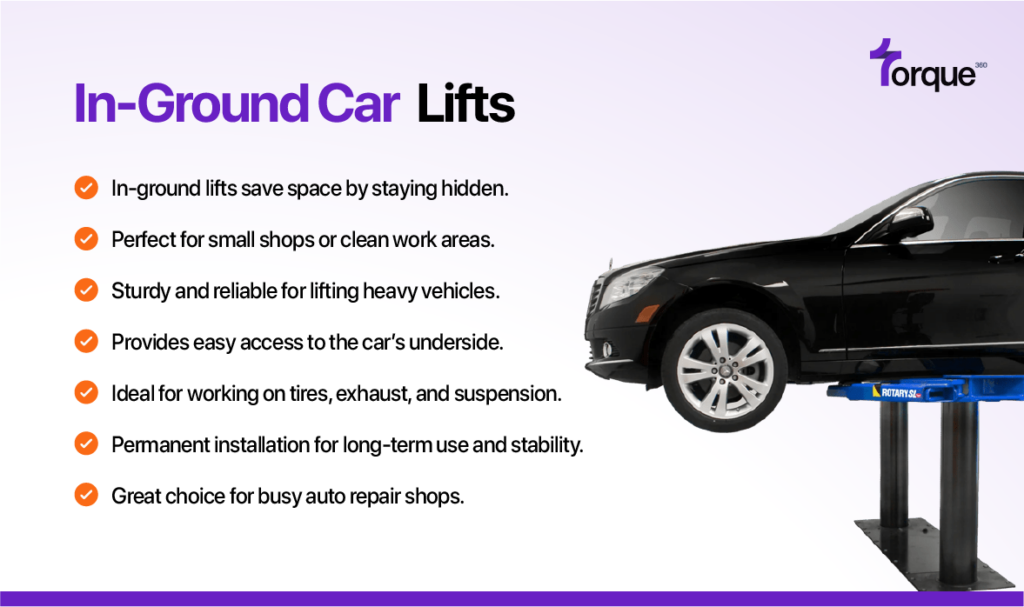
6. Parking Lifts
A parking lift is a tool that helps save space in a garage. It lifts one car above another, allowing you to park two cars in the same space.
This is especially useful if you have limited room in your garage or want to fit more cars.
Here’s more:
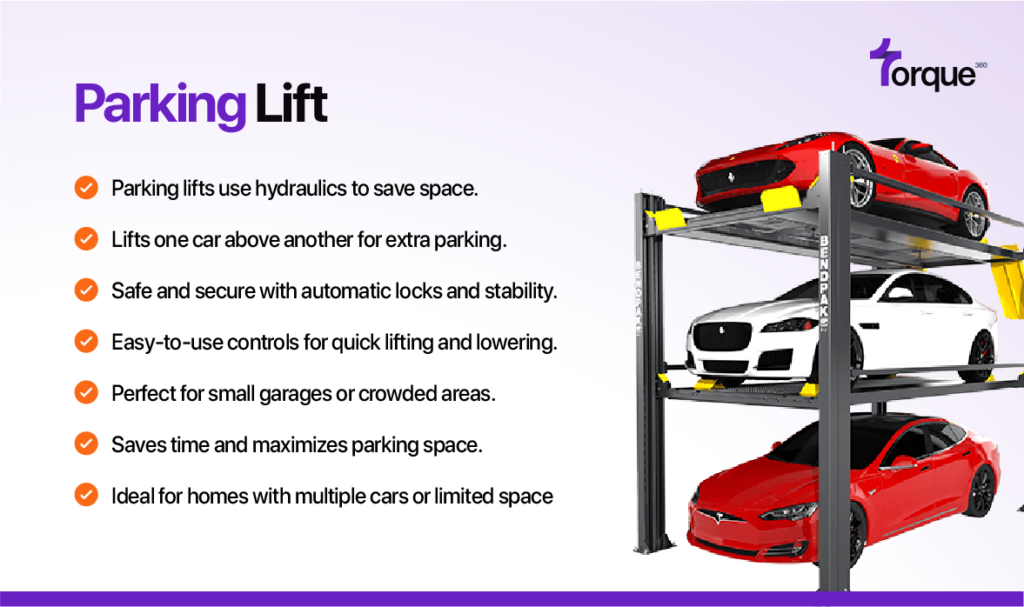
Here’s the “Top 10 Car Lifts for Auto Repair Shop.”
How to Choose the Auto Repair Lift?
Car lifts are essential tools for auto repair shops. They help workers easily lift and support cars, making it simpler to fix them. But choosing the right auto repair lift depends on your shop’s needs, the space available, and the types of cars you work on.
Here, you’ll learn how to pick the best car lift, so you can make the right choice for your shop.
Consider Your Repair Shop Needs
Before looking at the different types of auto repair lifts, take a moment to think about what your shop needs. Consider these important factors.
Vehicle Size and Weight
First, think about the kinds of vehicles your shop works on most often. Do you mainly service cars, trucks, SUVs, or even special vehicles like RVs or motorcycles?
You’ll want to consider how heavy and large these vehicles are to pick the right auto repair lift.
It’s important to know the heaviest vehicle you’ll work on. If your shop often handles vehicles over 10,000 pounds, you’ll need a lift that can handle that weight.
For example, a four-post auto repair lift with a capacity of 40,000 pounds might be the best choice for your shop.
Match Your Shop’s Services
Think about the different services your shop offers, like general repairs, bodywork, tire services, and more. Make sure the auto repair lift you pick fits the tasks your technicians do every day.
For example, if your shop does a lot of bodywork and restoration, you might want a lift with adjustable height settings. This will make it easier for your team to reach the undercarriage and work on detailed repairs.
Fit Your Space
When choosing auto repair lifts, it’s important to think about your shop’s space. Different lifts need different amounts of room, so you need one that fits comfortably and helps your shop run smoothly.
Here are some things to consider:
- Measure your shop’s available floor space.
- Plan the layout around the lift.
- Leave 12 feet from the posts to the back wall.
- Allow 9 feet for asymmetrical lifts.
- Check the ceiling height for clearance.
- Look for low-profile lifts if space is tight.
- Make sure the lift doesn’t block operations.
For shops with limited ceiling height, low-profile lifts or portable lifts might be a good choice. Also, be sure to check the lift’s height before buying it, so it fits your space properly.
And don’t forget about the comfort of your team! Make sure there’s enough ground clearance for your technicians to work without straining their backs or necks.
Your Shop’s Future Growth
When choosing auto repair lifts, think about your shop’s future growth. You might want to pick a lift with a higher weight capacity than what you need right now. This way, it can handle larger vehicles or more work in the future.
You could also consider a modular lift system. These lifts let you upgrade the capacity as your business grows. This gives you long-term flexibility and ensures your lift will always meet your auto shop’s needs. Just like lifts, and diagnostic tools, are essential for shops, shop management software is also a crucial tool to meet all your business needs.
Practical Tips for Choosing the Right Auto Repair Lift
Locking Systems
When selecting auto repair lifts, make sure to look for ones that have automatic locking systems. These systems automatically lock into place when the lift reaches a certain height, keeping the lift stable and secure.
This feature is important because it helps prevent accidents, ensuring the vehicle stays safely in position while your team works on it.
A reliable locking system adds an extra layer of safety, so both your technicians and vehicles are protected while using the lift.
Have Overload Protection
When choosing auto repair lifts, it’s a good idea to look for ones that have overload protection. This feature helps prevent the lift from lifting beyond its safe weight limit. If the weight exceeds the lift’s capacity, the system will automatically stop the lift from going any higher.
This is an important safety feature for your auto mechanics. It not only helps protect them from potential injuries but also reduces the chance of damaging the equipment.
With overload protection, you can keep your shop running smoothly and safely.
Easy to Use for Your Technicians
When selecting auto repair lifts, it’s important to choose one that’s easy for your technicians to operate. Look for lifts with simple, intuitive controls and smooth lifting systems. This will help make the work process faster and reduce the time spent on setting up the lift.
For example, an auto shop might invest in a hydraulic lift that has user-friendly controls and adjustable settings.
These features allow technicians to quickly lift vehicles without needing a lot of training. The easier the lift is to use, the more efficiently your shop can run, saving both time and effort.
Easy to Maintain
When picking auto repair lifts, it’s important to think about how easy they are to maintain. Regular maintenance, like vehicle inspections, lubrication, and having spare parts available, will help your lift last longer and work better.
It’s a good idea to choose lifts from well-known, trusted manufacturers who offer reliable support services. A lift from a brand that’s known for strong, durable construction will stand the test of time.
You should also look for lifts that come with maintenance packages, so you can keep everything running smoothly. This way, your auto repair lifts will stay in top condition and keep working well for many years.
Weigh the Cost and Value
When choosing auto repair lifts, it’s important to think about both the initial cost and the long-term value.
While it might be tempting to pick a cheaper option, consider how much the lift will cost to maintain and repair over time. A lift that’s built to last and works well will save you money in the long run.
Take into account the lift’s durability, how well it performs, and the cost of keeping it in good shape. Also, think about how much time it will save your technicians on repairs, which can make your shop more efficient.
Try to find a lift that balances a good price with strong quality, so you get the best value for your money in the long run.
FAQs
1. What is the best car lift?
The best car lift depends on your specific needs, such as the type of vehicles you work with, available space, and budget. However, well-known and reputable brands like Bendpak, Dannmar, and Maxjax are often highly recommended for their durability, safety features, and reliability.
2. How much does a single lift cost?
The cost of a single-car lift can range from $1,500 to $15,000, depending on factors like the type of lift, its specifications, and the brand. Features such as weight capacity, lift height, and durability can also affect the price.
3. How thick should concrete be for a car lift?
The concrete for a car lift should be at least 4 inches thick to ensure proper stability and weight-bearing capacity. However, for added strength and safety, it is recommended to have a thickness of 6 inches.





